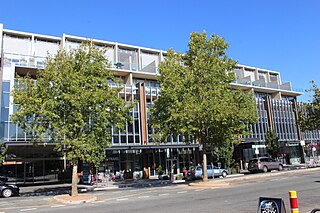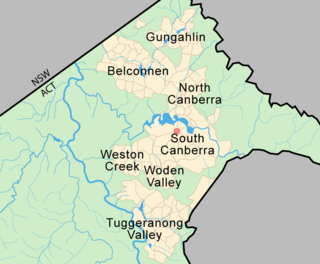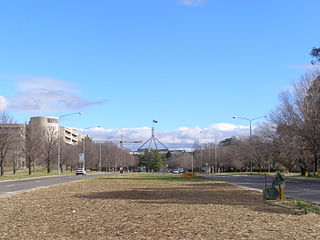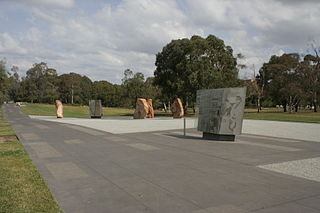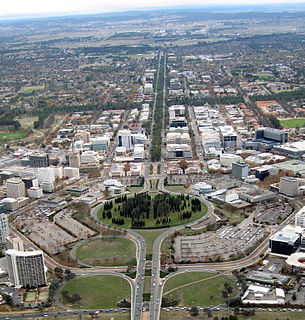
City Hill is a park located in Canberra, Australia on one of the points of the Parliamentary Triangle, a feature of Walter Burley Griffin's plan for the city. The park is surrounded by Vernon Circle, at the south end of Northbourne Avenue but the precinct extends to London Circuit and is an integral part of the city centre design. To the south of the hill Northbourne Avenue becomes Commonwealth Avenue, and further along is Commonwealth Avenue bridge.

Canberra is the capital city of Australia. Founded following the federation of the colonies of Australia as the seat of government for the new nation, it is Australia's largest inland city and the eighth-largest city overall. The city is located at the northern end of the Australian Capital Territory; 280 km (170 mi) south-west of Sydney and 660 km (410 mi) north-east of Melbourne.

Australia, officially the Commonwealth of Australia, is a sovereign country comprising the mainland of the Australian continent, the island of Tasmania, and numerous smaller islands. It is the largest country in Oceania and the world's sixth-largest country by total area. The neighbouring countries are Papua New Guinea, Indonesia, and East Timor to the north; the Solomon Islands and Vanuatu to the north-east; and New Zealand to the south-east. The population of 26 million is highly urbanised and heavily concentrated on the eastern seaboard. Australia's capital is Canberra, and its largest city is Sydney. The country's other major metropolitan areas are Melbourne, Brisbane, Perth, and Adelaide.
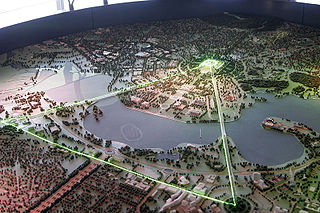
The National Triangle, which is referred to as the Parliamentary Triangle, is the ceremonial precinct of Canberra, containing some of Australia's most significant buildings. The National Triangle is formed by Commonwealth, Kings and Constitution Avenues. Buildings within the National Triangle have been located and designed intentionally for visual effect, and those of national significance are popular tourist attractions.
The hill was planted in 1921. The design, supervised by Charles Weston, Canberra's first Superintendent of Parks and Gardens, was to emphasise the vistas along the six avenues radiating from the hill and reinforce the focus that Griffin placed on the hill as forming part of the Parliamentary triangle. At the centre of the hill is a flagpole flying the ACT flag since 1989 when the territory became self-governing. Immediately surrounding the flagpole are double staggered rows of closely spaced Roman cypresses (Cupressus sempervirens Stricta). Radiating outwards are twelve oval shaped groups of Roman cypresses and six groups of Monterey pines (Pinus radiata) reinforcing the symmetrical nature of the design. In 2014 the Canberra Centenary Column was added to the park, to commemorate Canberra's centenary.

The Australian Capital Territory, formerly known as the Federal Capital Territory until 1938 and commonly referred to as the ACT, is a federal territory of Australia containing the Australian capital city of Canberra and some surrounding townships. It is located in the south-east of the country and is an enclave within the state of New South Wales. Founded after federation as the seat of government for the new nation, all important institutions of the Australian federal government are centred in the Territory.

Cupressus sempervirens, the Mediterranean cypress, is a species of cypress native to the eastern Mediterranean region, in northeast Libya, southern Albania, coastal Bulgaria, southern coastal Croatia, southern Montenegro, southern Bosnia and Herzegovina, southern Greece, southern Turkey, Cyprus, northern Egypt, western Syria, Lebanon, Malta, Italy, Israel, western Jordan, and also a disjunct population in Iran.

The Canberra Centenary Column is a sculpture in City Hill, Canberra, Australia. It was built to commemorate the city's centenary, and unveiled on 11 March 2014.
The park is centrally located and well-known, but it is rarely visited as it is away from shops and public areas and is difficult to access because it is surrounded by a major road. The prominent flagpole at the centre of Vernon Circle is not actually at the highest point of City Hill. The highest point of City Hill is to the south east, overlooking Lake Burley Griffin. Unusually for the centre of a large city and as a result of the relative isolation of City Hill, a small variety of mushrooms can be found growing under the pine trees.

Lake Burley Griffin is an artificial lake in the centre of Canberra, the capital of Australia. It was completed in 1963 after the Molonglo River—which ran between the city centre and Parliamentary Triangle—was dammed. It is named after Walter Burley Griffin, the American architect who won the competition to design the city of Canberra.


